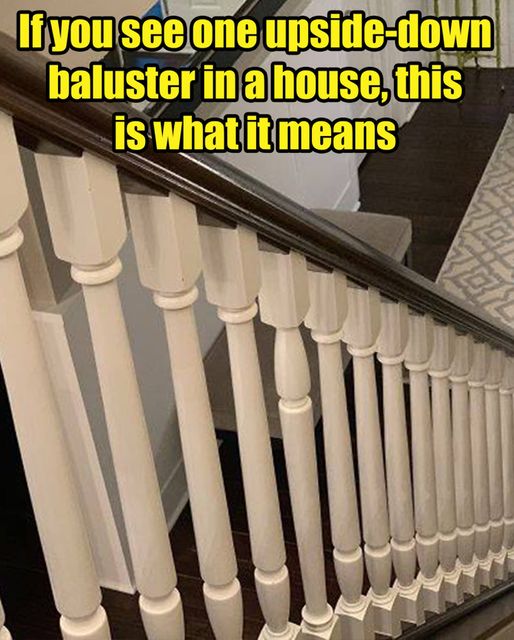Exploring older homes often reveals intriguing architectural oddities. Among them, the presence of a solitary baluster, conspicuously inverted amidst its upright counterparts. Is this an inadvertent error in construction, or does it hold deeper significance?
The Oversight or Intention: Deciphering Upside-Down Balusters

In scrutinizing staircases of older homes, one might encounter the puzzling sight of a lone baluster, defying the convention by standing upside down. While human fallibility could explain such anomalies, historical and superstitious contexts suggest otherwise.
Superstition or Tradition: The Curious Tales Behind Upside-Down Balusters

In folklore and tradition, upside-down balusters are steeped in mystical symbolism. Tales from various cultures attribute protective qualities to these inverted spindles, warding off evil spirits and bringing luck to inhabitants. Scottish lore even ties them to clandestine support for historical figures like Bonnie Prince Charlie.
Historical Whimsy: Upside-Down Balusters in Architectural Evolution

Historical accounts reveal instances where upside-down balusters were intentionally incorporated as expressions of reverence or humility. In some old houses, craftsmen deliberately crafted imperfections to acknowledge the imperfect nature of humanity compared to the divine. Examples abound in government buildings like the South Dakota State Capitol and the Wyoming State Capitol, each bearing testament to this age-old tradition.
Interpreting the Unconventional: Contemporary Perspectives on Upside-Down Balusters

Today, these architectural oddities serve as focal points, prompting discussions on their origins and significance. Whether viewed through a lens of superstition, tradition, or historical homage, upside-down balusters continue to intrigue and captivate, inviting us to ponder the hidden narratives within our built environment.
The presence of an upside-down baluster in a staircase transcends mere oversight; it embodies layers of history, tradition, and belief. As we navigate the corridors of older homes, these architectural anomalies serve as portals to bygone eras, offering glimpses into the rich tapestry of human imagination and ingenuity. So, the next time you encounter an inverted spindle, take a moment to ponder the stories it holds and the mysteries it unveils.
Discovering Distinctive Staircase Elements: Unveiling Historic Home Treasures

Before the advent of modern vacuum cleaners, banishing dust from stair corners was a laborious task, vexing homeowners with its persistent presence. However, ingenious solutions emerged in the late 19th century to simplify this chore, giving rise to the practical yet charming dust corners. Alongside these, stair rods emerged, serving both functional and ornamental purposes in traditional homes.
Dust Corners: Simplicity Meets Charm

In the 1890s, the invention of stair corner dust guards brought relief to households grappling with the perpetual accumulation of dust in hard-to-reach stair corners. Beyond their utilitarian function, these quaint additions imparted a touch of elegance to wooden staircases, enhancing their visual appeal. Today, they serve as decorative accents, effortlessly marrying form and function in interior design. Consider embellishing awkward corners in your home, such as those between walls and fireplace moldings, with these timeless treasures.
Where to Find Dust Corners

Seek out corner guards at specialty retailers like House of Antique Hardware for authentic vintage charm. You could alternatively explore online marketplaces such as Amazon and Etsy for a diverse array of options. From classic designs to whimsical interpretations like star-spangled motifs, there’s a dust corner to suit every aesthetic preference and home décor style.
Stair Rods: Bridging the Gap Between Tradition and Modernity

Originally conceived to secure runner carpets to wooden staircases, stair rods seamlessly blend functionality with visual allure. While their practical role has diminished with modern carpet installation techniques, their aesthetic appeal remains undiminished. Today, stair rods serve as nostalgic reminders of a bygone era, adding a touch of vintage elegance to contemporary interiors. Whether crafted from brass, wrought iron, or other materials, these timeless accessories evoke a sense of timeless sophistication.
Where to Find Stair Rods

Embark on your quest for stair rods at specialty hardware stores catering to period homes or explore online retailers like Wayfair and Amazon for a diverse selection. Whether you opt for classic designs or modern interpretations, stair rods offer a versatile means of infusing your staircase with character and charm.
